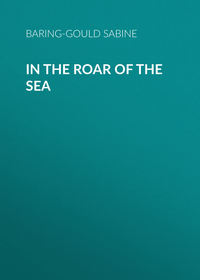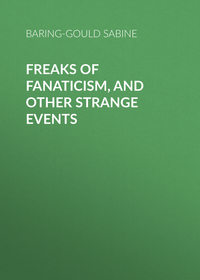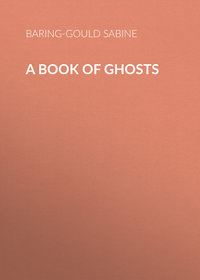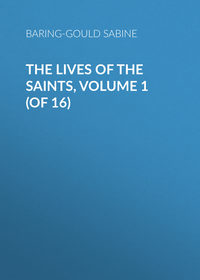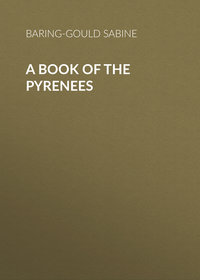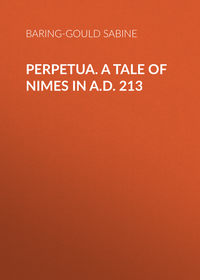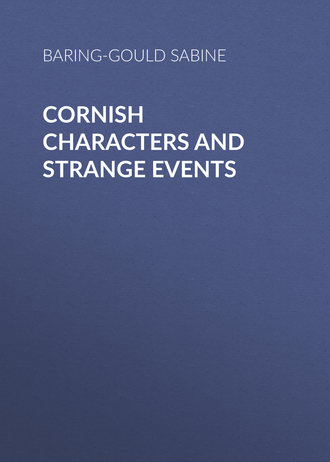 полная версия
полная версияCornish Characters and Strange Events
Call was one of those admirable, self-made men who have been empire-makers in the East, and, better than that, have been makers of the English name as synonymous with all that is powerful and true and just. He well deserved the title accorded to him. He was a man of whom Cornwall may be proud, and it needed no trumpets in his arms and fictions about the origin of his family to make the name honourable.
As Dr. Johnson said, "There are some families like potatoes, whose only good parts are underground."
The authorities for the life of Sir John Call are Playfair's British Family Antiquity, 1809; Clement R. Markham's Memoir on the Indian Surveys, 1878; H. G. Nicholl's Forest of Dean; and Neota, by Charlotte Hawkey, 1871.
The grant of the baronetcy to Sir John Call, dated 1795, is now in the Museum of the Royal Institution of Cornwall, at Truro.
JOHN KNILL
In August, 1853, appeared the following account in the Gentleman's Magazine: —
"An eccentric old gentleman of the name Knill, a private secretary some fifty or sixty years ago to the Lord-Lieutenant of Ireland, becoming afterwards collector of the port of S. Ives, built a three-sided pyramid of granite on the top of a high hill, near the town of S. Ives. The pyramid is represented as a pocket edition of an Egyptian one, and in it this gentleman caused a chamber to be built, with a stone coffin, giving out his intention to be buried there, and leaving a charge on an estate to the corporation of S. Ives for the maintenance and repair, etc., of the pyramid. He, however, died in London; and by his latest will, so far from perpetuating the ostentatious idea, desired that his body should be given up to the surgeons for dissection, a penance, it is supposed, for past follies, after which the remains were buried in London. The pyramid, however, still stands as a landmark. On one side, in raised letters in granite, appear the words 'Hic jacet nil.' It was understood that the 'K' and another 'l' would be added when the projector should be placed within; and on the other side, 'Ex nihilo nil fit,' to be filled up in like manner, Knill. The mausoleum obtained then, and still bears the name of Knill's Folly."
This account, full of inaccuracies, called forth a letter to the editor from a relative of John Knill, at Penrose, by Helston, dated October, 1853, which appeared in the November issue of the same magazine. He stated that John Knill was educated for the law, but did not adopt it as a profession. He preferred to accept the office of collector of customs at S. Ives. After a while he was sent as Inspector-General of Customs to the West Indies, whence he returned to his duties at S. Ives, after having discharged his office of inspectorship. In 1777 the Earl of Buckinghamshire, who was recorder of S. Ives, invited Mr. Knill to accompany him to Ireland as his private secretary, when he, the earl, had been made lord-lieutenant. The offer was accepted.
In 1782, thirty years before his death, he erected the mausoleum, partly actuated by a philanthropic motive as affording a landmark to ships approaching the port, and partly by a wish to find employment for men at a time of considerable distress, having also a desire to be buried there, if the ground could be consecrated. This intention was afterwards abandoned.
Mr. Knill resided for some years previous to his death in Gray's Inn, and was a bencher of that society. He died there in 1811, and was buried in the vaults of S. Andrew's, Holborn. On one side of the monument is the word "Resurgam." On the second side, "I know that my Redeemer liveth," and on the third is no inscription at all, and the silly puns given by the informant of the Gentleman's Magazine had no existence save in the imagination of the correspondent.
The same writer adds: "Though he had a wide circle of acquaintances and he was highly esteemed by all who knew him, he resisted every invitation to dine in private society, and for many years past dined at Dolly's Coffee House, Paternoster Row, walking through the chief avenues of the town in the course of the day, in order to meet his friends and to preserve his health by moderate exercise."
We are able to supplement this scanty record from a memoir of him by Mr. John Jope Rogers, of Penrose, published in 1871 by Cunnack, of Helston.
John Knill was born at Callington on January 1st, 1733. His mother was a Pike of Plympton, and her mother was an Edgcumbe of Edgcumbe, it is stated in the memoir, but no entry of any such marriage is in the pedigree of the Edgcumbes in Vivian's Heralds' Visitations of Devon.
Mr. Knill was very desirous to trace a descent from the family of Knill of Knill, in Hereford, but entirely failed to do so.
John Knill's mother, one of the seven daughters of Mr. Pike, married secondly Mr. Jope, and it is thus that the portrait of the subject of this memoir came into the possession of Mr. John Jope Rogers, of Penrose, author of the memoir.
John Knill, according to Davies Gilbert, "served his clerkship as an attorney in Penzance, and from thence removed to the office of a London attorney, where, having distinguished himself by application and intelligence, he was recommended to the Earl of Buckinghamshire, who, at that time, held the political interests of S. Ives, to be his local agent." In the year 1762 he was appointed collector of customs at S. Ives, in Cornwall, and held it during twenty years, at the end of which time he wrote to Mr. William Praed, March 30th, 1782: "I purpose to be in London in May, in order to resign my office of collector, which I shall finally quit at the end of next midsummer quarter."
In November, 1767, he was chosen mayor of S. Ives, and lived in a red-brick house facing the beach, in Fore Street. Although mayor and collector of customs, it was strongly believed that he was in league with smugglers and wreckers.
One day, during the latter half of the eighteenth century, a strange vessel ran on the rocks on the Hayle side of Carrick Gladden, and the crew escaped to land and disappeared. The ship, now a derelict, had apparently no owner, and next day a number of people boarded her, and found her full of chinaware and other smuggled goods. The ship's papers could not be found; they had been carried off when the crew deserted her, and it was strongly supposed that they were destroyed, as implicating Knill and Praed, of Trevetho. The customs officer, Roger Wearne, went on board and stuffed his clothes full of china; having a pair of trousers on with a very ample and baggy seat, he thought he could not do better than stow away some of the choicest pieces of porcelain there. But as he was getting down the side of the ship into the boat, very leisurely, so as not to injure his spoils, a comrade, getting impatient, struck him on the posteriors with the blade of his oar, shouting to him, "Look out sharp, Wearne!" and was startled at the cracking noise that ensued, and the howl of Wearne when the broken splinters of china entered his flesh.
In 1773 the Government sent him to Jamaica to inspect the ports there; he remained in the West Indies one year, and used his eyes and ears, for in 1779 he wrote an account of the religion of the Coromandel negroes for Bryant Edwards' History of the West Indies, from information he then and there gathered. For his services he received from the Board of Customs the substantial sum of £1500. He returned to his duties at S. Ives in 1774. In 1777 he became private secretary to the Earl of Buckinghamshire, in Dublin, but he returned to S. Ives after six months in Ireland. In 1779 he speculated in a bootless search for treasure, which the notorious pirate, Captain John Avery, was supposed, on his return from Madagascar, to have secreted near the Lizard. But, as none of the Lives of that freebooter gave any hint of his having done so, the attempt was not the least likely to lead to satisfactory results. Davies Gilbert says that Knill equipped some small vessels to act as privateers against smugglers, but if local tradition may be relied on, these vessels were only nominally for this purpose, and were actually engaged in running contraband goods; but this is highly improbable.
In 1782 he was employed in the service of the customs as inspector of some of the western ports, making occasional visits to London, where he settled for the rest of his days. In 1784 he purchased chambers in Gray's Inn Square, where he died on March 29th, 1811, at the age of seventy-seven. He was painted by Opie in 1779, dressed in a plain suit of blue, with frilled shirt and ruffles. He made his half-brother, the Rev. John Jope, of S. Cleer, his sole executor.
It was in the year 1782 that John Knill erected his mausoleum on Worral Hill, on land purchased from Henry, Lord Arundell, for five guineas. The total cost of the monument was £226 1s. 6d. Sixpence a year is paid to the owner of Tregenna for a right of way to the obelisk. By a deed dated May 29th, 1797, Knill settled upon the mayor and capital burgesses of S. Ives, and their successors for ever, an annuity of £10 as a rent-charge, to be paid out of the manor of Glivian, in Mawgan, which sum is annually to be put into a chest which is not to be opened except at the end of every five years. Then, out of the accumulated sum, a dinner was to be given to the mayor, collector of customs, and vicar of S. Ives, and two friends to be invited by each of them, and £15 to be equally divided among ten girls, natives of S. Ives, under ten years old, who should, between 10 a.m. and noon on S. James the Apostle's Day, dance and sing round the mausoleum, to the fiddling of a man who was to receive a pound for so doing and for fiddling as the procession of girls went to the obelisk and returned. One pound was to be laid out in white ribbons for the damsels and a cockade for the fiddler. Some of the money was to go to keep the mausoleum in repair, and there were certain benefactions also recorded.
The first Knillian celebration took place in July, 1801, when, according to the will of the founder, a band of little girls, all dressed in white, with two widows and a company of musicians, marched in procession to the top of the hill, where they danced about the monument, then, as Knill desired, sang the Hundredth Psalm to its old melody, and after that returned in the same order to S. Ives. The ceremony still takes place every fifth year.
In dancing the children sing the following in chorus: —
Shun the bustle of the bay,Hasten, virgins, come away;Hasten to the mountain's brow,Leave, O leave, S. Ives below.Haste to breathe a purer air,Virgins fair, and pure as fair;Fly S. Ives and all her treasures,Fly her soft voluptuous pleasures;Fly her sons and all their wiles,Lushing in their wanton smiles;Fly the splendid midnight halls;Fly the revels of her balls;Fly, O fly the chosen seat,Where vanity and fashion meet.Hither hasten from the ring,Round the tomb in chorus sing,And on the lofty mountain's brow, aptly dight,Just as we should be, all in white,Leave all our troubles and our cares below.THOMAS TREGOSS
A certain Roscadden going on a pilgrimage in the days before the Reformation, and being absent some years, was surprised on his return to find that his wife had borne one if not more children. Very much and very naturally put out, he consulted with one John Tregoss, who advised him to settle his estate upon some friend whom he could trust, for the use and benefit of his children whom he would own, and for the wife not to be left absolutely destitute in the event of his death. Mr. Roscadden approved of this counsel, and constituted John Tregoss his heir absolutely, but always with the understanding that the said Tregoss should administer his estate according to the wishes and instructions of Roscadden. But this gentleman dying soon after, John Tregoss entered on possession of the estate, "turned the wife and children out of doors, who for some time were fain to lye in an hog-stye, and every morning went forth to the Dung-hill, and there upon their faces imprecated and prayed that the vengeance of God might fall upon Tregoss and his posterity for this so perfidious and merciless deed.
"And after this, God's severe but righteous judgments fell upon Tregoss's family. For his son Walter, one day riding upon a Horse in a fair way, the horse threw him, and broke his neck: and some of his issue came to untimely ends, and it is observed that a curse hath remained ever since: and this Mr. Tregoss of whom we write was so sensible of it, that it cost him many fervent prayers to God for the removal of that dreadful curse, as himself assured a bosom friend" – but it does not seem to have occurred to him to give up the heritage to the Roscaddens – that is, if he were the possessor.
The family of Tregose, or Tregosse, was one of the oldest in the neighbourhood of S. Ives. The names of Clement and John Tregose of S. Ives appear in the Subsidy Roll of 1327. In the list of circa 1520, Thomas Tregoos' lands in Towednack were assessed at the yearly value of 13s. 4d., and those of John Tregoz, in the parish of S. Ives, at 11s.; but Thomas also had lands at S. Ives, valued the same as those of John.
In 1641, William Tregose, gent., had at S. Ives goods to the annual value of £3.
Thomas Tregoss, the subject of this notice, was the son of William Tregoss of S. Ives. His parents were strong Puritans and very austere, and they hedged about their son with restrictions, not suffering him to partake in games or any childish relaxations from the strain of study or the contemplation of religious themes. At first he seemed to be of poor capacity, but at the age of seven years he began to show that he had a quick apprehension and a retentive memory. Cut off from all worldly distractions, he was allowed but one direction in which his faculties and his ambitions could stretch and expand. He had not the force of character and strength of will to revolt against the numbing restraints that bound him in. His only play as a boy was standing on a chair and preaching to his fellow pupils.
He was sent to Oxford and admitted into Exeter College, and after a few years spent there, returned to S. Ives; and as the Parliamentary Commissioners had ejected the vicar, he was thrust in as Puritan preacher in 1657, and he then married a Margaret Sparrow of the same way of thinking.
The life of Thomas Tregoss, as given by Samuel Clark in his Lives of Some Eminent Persons, 1683, is interspersed with Remarkable Providences and Extraordinary Judgments, but for the most part they are neither remarkable nor interesting.
The following is, perhaps, an exception: —
Shortly after his arrival at S. Ives, in the summer, the greater portion of the fishing season had passed without the pilchards appearing, and this to the great distress of the people. By the advice of Tregoss a day was set apart for humiliation and prayer, and next day a shoal of pilchards arrived.
In the ensuing summer the fishermen, having taken a great number of fishes on the Saturday, wanted to spread and dry their nets on the Sunday. Tregoss learning this, came forth and rebuked and denounced God's judgment on them if they should profane the "Sabbath" in this manner. They did not hearken to him, observing that their nets must be dried or would rot. From that day no more pilchards visited the bay during that season.
From S. Ives Tregoss was transferred to Mylor in October, 1659, but was ejected from the living on August 24th, 1660, as not ordained, and unwilling to receive ordination, and to subscribe to the articles and confirm to the liturgy. However, he continued to preach to a privately assembled number of puritanically minded people, and he was proceeded against and committed to the custody of the marshal in Launceston gaol, where he remained for three months, and was then released by order of the Deputy Lieutenant.
In September, 1663, he removed to Kigilliath, near Penryn. On October 1st, 1664, whilst he and his wife were lying awake in bed, they experienced an earthquake shock, and this he held to be "a symbolick image of that trembling Heartquake which he shortly felt in his conversion."
On January 1st ensuing, he fell into deep despondency and the spirit of bondage – his liver being probably out of order – till he fancied himself relieved by receiving the spirit of adoption. He had been converted half a dozen times before, but never before preceded by an earthquake, so that there could be no mistake about its reality this time.
Fired with new zeal, he broke into Mabe church at the head of a number of his adherents, mounted the pulpit, and harangued his congregation. For this he was arrested and imprisoned again in Launceston gaol, but was shortly released, July 29th, 1665; and he had the pleasing satisfaction of knowing that a bull had gored Justice Thomas Robinson, who had sent him to prison.
Undeterred by what he had gone through, he again invaded Mabe church, and was again committed to gaol on September 18th, but was once more released, on December 14th.
On February 4th, 1666, he once more broke into the parish church of Mabe at the head of a body of Puritans, and was again arrested and sent to the marshal at Bodmin, but by the order of the King was at once set free.
In 1669 he was at Great Torrington, where he preached, and was sent to Exeter gaol, but was at once bailed out. He died at Penryn in January, 1672.
On September 4th, 1775, John Wesley preached at S. Ives "in the little meadow above the town." He wrote in his diary that "the people in general here (excepting the rich) seem almost persuaded to be Christians. Perhaps the prayer of their old pastor, Mr. Tregoss, is answered even to the fourth generation."
ANTHONY PAYNE
Anthony Payne, the "Falstaff of the West," was born in the manor house, Stratton, the son of a tenant farmer, under the Grenvilles of Stowe. The registers do not go back sufficiently far to record the date of his birth. The Tree Inn is the ancient manor house in which the giant first saw the light. He rapidly shot up to preternatural size and strength. So vast were his proportions as a boy, that his schoolmates were accustomed to work out their arithmetic lessons in chalk on his back, and sometimes even thereon to delineate a map of the world, so that he might return home, like Atlas, carrying the world on his shoulders for his father with a stick to dust out.
It was his delight to tuck two urchins under his arms, one on each side, and climb, so encumbered with "his kittens," as he called them, to a height overhanging the sea, to their infinite terror, and this he would call "showing them the world." A proverb still extant in Cornwall, expressive of some unusual length, is "As long as Tony Payne's foot."
At the age of twenty-one he was taken into the establishment at Stowe. He then measured seven feet two inches in height without his shoes, and he afterwards grew two inches higher. He was not tall and lanky, but stout and well proportioned in every way. The original mansion of the Grenvilles at Stowe still in part remains as a farmhouse. The splendid house of Stowe, built by the first Earl of Bath, was pulled down shortly after 1711, and it was said that men lived who had seen the stately palace raised and also levelled with the dust. This was at a little distance further inland than the old Stowe that remains. The Grenvilles had also a picturesque house at Broom Hill, near Bude, with fine Elizabethan plaster-work ceilings, now converted into labourers' cottages.
At Stowe Anthony Payne delighted in exhibiting his strength. In the hurling-ground a rough block of stone is still pointed out as "Payne's cast," lying full ten paces beyond the reach whereat the ordinary player could "put the stone."
It is said that one Christmas Eve the fire languished in the hall. A boy with an ass had been sent into the wood for faggots. Payne went to hurry him back, and caught up the ass and his burden, flung them over his shoulder, and brought both into the hall and cast them down by the side of the fire.
On another occasion, being defied to perform the feat, he carried a bacon-hog from Kilkhampton to Stowe. Then came the Civil War, when Charles I and his Parliament sought to settle their differences on the battlefield. Cornwall went for the King, and Anthony Payne had the drilling and manœuvring of the recruits from Kilkhampton and Stratton. At one time Sir Beville Grenville had his head-quarters at Truro, but the great battle of Stamford Hill, May 16th, 1643, was fought but eight miles from Stowe, and on the night preceding it Sir Beville Grenville slept in his house at Broom Hill. The battle was desperate, the Royalist soldiers being outnumbered, and attacked; amidst them was Anthony Payne, mounted on his sturdy cob Samson, rallying his troopers and terrorizing the enemy, who fled. At the next pitched battle at Lansdown, near Bath, the forces of the King were defeated and Sir Beville was killed. Anthony Payne, having mounted John Grenville, then a youth of sixteen, on his father's horse, had led on the Grenville troops to the fight. The Rev. R. S. Hawker gives a letter from the giant to Lady Grace Grenville, conveying to her the news of the death of her husband; but it is more than doubtful whether this be genuine. He says of it: "It still survives. It breathes, in the quaint language of the day, a noble strain of sympathy and homage." It does not exist except in Mr. Hawker's book, and is almost certainly a fabrication by him.
At the Restoration, Sir John Grenville was created Earl of Bath, and was made governor of the garrison of Plymouth, and he then appointed Payne halberdier of the guns. The King, who held Payne in great favour, made him a yeoman of his guards, and Sir Godfrey Kneller, the Court artist, was employed to paint his portrait.
Whilst in Plymouth garrison an incident occurred that has been recorded by Hawker. At the mess-table of the regiment, during the reign of William and Mary, on the anniversary of the day when Charles I had been beheaded, a sub-officer of Payne's own rank had ordered a calf's head to be served up. This was a coarse and common annual mockery of the beheaded king indulged in by the remnants of the old fanatical Puritan party. When Payne entered the room his comrades pointed out the dish to him. Anthony flared up, and flung the plate and its contents out of the window. A quarrel and a challenge ensued, and at break of day Payne and his antagonist fought with swords on the ramparts, and Anthony ran the offender through the swordarm and disabled him, as he shouted, "There's sauce for thy calf's head."
Hawker, who tells the story, supposed that the incident occurred during the reign of George I. But Anthony died at an age little short of eighty, and was buried at Stratton July 13th, 1691, and William of Orange did not die till 1702.
After his death at Stratton, which took place in the house where he was born, neither door nor stairs would afford egress for the large coffined corpse. The joists had to be sawn through, and the floor lowered with rope and pulley, to enable the giant to pass out to his last resting-place, under the south wall of Stratton Church.12
The history of the vicissitudes through which went the painting by Kneller is peculiarly interesting.
When Stowe was dismantled, on the death of the Earl of Bath, the picture was removed to Penheale, another Cornish residence of the Grenville family.
But here the portrait of him who had done so much for the house was not valued, and was soon forgotten. Gilbert, the Cornish historian, in one of his rambles, whilst staying at an old inn in Launceston, was informed that this painting was still extant, and he went to Penheale, where the farmer's wife occupying the house said that she did indeed possess "a carpet with the effigy of a large man on it," that had been given to her husband by the steward on the estate. It was rolled up, and in a bad and dirty condition. She gladly sold it to C. S. Gilbert for £8. On Gilbert's death his effects were sold at Devonport, and a stranger bought it for £42. In London it was recognized as the work of Kneller, and was resold for the sum of £800. It next appeared amongst the effects of the late Admiral Tucker, at Trematon Castle; and when the sale took place this picture was bought by a gentleman in Devon. Finally Mr. (now Sir) Robert Harvey purchased it, and most generously presented it to the Royal Institution of Cornwall.


